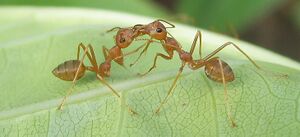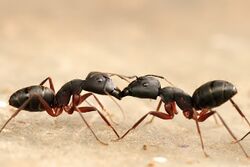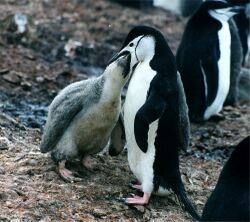Biology:Trophallaxis

Trophallaxis (/ˌtroʊfəˈlæksɪs/) is the transfer of food or other fluids among members of a community through mouth-to-mouth (stomodeal) or anus-to-mouth (proctodeal) feeding. Along with nutrients, trophallaxis can involve the transfer of molecules such as pheromones, organisms such as symbionts, and information to serve as a form of communication.[1] Trophallaxis is used by some birds, gray wolves, vampire bats, and is most highly developed in eusocial insects such as ants, wasps, bees, and termites.
Etymology
Tropho- (prefix or suffix) is derived from the Greek trophé, meaning 'nourishment'. The Greek 'allaxis' means 'exchange'.[2] The word was introduced by the entomologist William Morton Wheeler in 1918.[3]
Evolutionary significance
Trophallaxis was used in the past to support theories on the origin of sociality in insects.[4][5] The Swiss psychologist and entomologist Auguste Forel also believed that food sharing was key to ant society and he used an illustration of it as the frontispiece for his book The Social World of the Ants Compared with that of Man.[6] Proctodeal trophallaxis allowed termites to transfer cellulolytic flagellates that made the digestion of wood possible and efficient.[7] Besides sociality, trophallaxis has evolved within many species as a method of nourishment for adults and/or juveniles,[8] kin survival,[8] transfer of symbionts,[9] transfer of immunity,[10] colony recognition[11] and foraging communication.[12] Trophallaxis has even evolved as a parasitic strategy in some species to obtain food from their host.[13] Trophallaxis can also result in the spreading of chemicals, such as pheromones, throughout a colony, which is significant in social colony functioning.[14]
Species have evolved anatomy to allow them to participate in trophallaxis, such as the proventriculus in the crops of Formica fusca ants.[14] This structure acts as a valve to enhance food storage capacity.[14] Likewise, the honey bee Apis mellifera is able to protrude their proboscis and sip nectar from the open mandibles of the donor bee.[12] Certain mechanisms have also evolved to initiate food sharing, such as the sensory exploitation strategy that has evolved in the common cuckoo brood parasites.[15] These birds have evolved brightly coloured gapes that stimulate the host to transfer food.[15]
Invertebrates

Trophallaxis is a form of social feeding in many insects that contributes to the formation of social bonds.[5] Trophallaxis serves as a means of communication, at least in bees, like M. genalis,[16] and ants.[17] Trophallaxis in M. genalis is part of a social exchange system, where dominant bees are usually the recipients of food.[16] It increases longevity of bees that have less access to food and decreases aggression between nest mates.[16] In the red fire ant, colony members store food in their crops and regularly exchange this food with other colony members and larvae to form a sort of "communal stomach" for the colony.[17] This is also true for certain species of Lasioglossum, such as the sweat bee Lasioglossum hemichalceum. L. hemichalceum will often exchange food with other members regardless of whether they are nestmates or not.[18] This is because cooperation among non-relatives offers more benefit than cost to the group.[18]
Many wasps, like Protopolybia exigua and Belonogaster petiolata, exhibit foraging behavior where adults perform trophallaxis with adults and between adults and larvae.[19][8] P. exigua carry nectar, wood pulp and macerated prey in its crop from the field to the nest for transfer; for larvae survival they carry amounts of prey proportional to the amount of larvae in the nest.[19] Voluntary trophallaxis in Xylocopa pubescens bees has led to the nest guarding behavior that the species is known for.[20] This bee species allows one adult to forage and bring nectar back for the rest of the nest population as a way to continually defend the nest while obtaining nutrients for all members of the colony.[20]
In termites,[9] proctodeal trophallaxis is crucial for replacing the gut endosymbionts that are lost after every molt. Gut symbionts are also transferred by anal trophallaxis in wood-eating termites and cockroaches.[21] Transfer of gut symbionts in these species is essential to digest wood as their food source. Carpenter ants transfer immunity through trophallaxis by the direct transfer of antimicrobial substances, increasing disease resistance and social immunity of the colony.[10][20]
In some species of ants, it may play a role in spreading the colony odour that identifies members.[22]
Honey bee foragers use trophallaxis in associative learning to form long-term olfactory memories, in order to teach nest mates foraging behavior and where to search for food.[12]
In addition, Vespula austriaca wasps also engage in trophallaxis as a form of parasitism with its host to obtain nutrients.[23] V. austriaca is an obligate parasite species that invades the nests of host species and obtains food by constraining the host with their legs and forcing trophallaxis.[23]
Vertebrates

Vertebrates such as some bird species, gray wolves, and vampire bats also feed their young through regurgitation of food as a form of trophallaxis. Food sharing in vertebrates is a form of reciprocity demonstrated by many social vertebrates.[24]
Wild wolves transport food in their stomach to pups and/or breeding females and share it by regurgitation, as a form of trophallaxis.[25] The recipient wolves often lick or sniff the donor wolf's muzzle to activate regurgitation and receive nutrients.[25] Vampire bats share blood with kin by regurgitation as a means of increasing their fitness through kin selection.[24]
Birds regurgitate food and directly transfer it into the mouths of their offspring as a part of parental care, such as the "crop milk" that is transferred by mother ring doves into the mouths of their young.[26] The cuckoo brood parasite is another bird species that engages in trophallaxis. The cuckoo bird uses mimicry, such as mimicking the eggshell colors and patterns of the host's eggs, to place their young in the nest of host species where they will be fed and reared at no expense to the cuckoo mother.[15] The cuckoo young can often mimic the begging call of an entire nest of the host species' young and have evolved intensely colored gapes; both of which act as supernormal stimuli, inducing the host bird to deliver food to them over their own young via trophallaxis.[15]
See also
- Evolutionary models of food sharing
- Regurgitation
- Superorganism
References
- ↑ E., Suárez, Mark; L., Thorne, Barbara (2000-01-01). "Rate, Amount, and Distribution Pattern of Alimentary Fluid Transfer via Trophallaxis in Three Species of Termites (Isoptera: Rhinotermitidae, Termopsidae)" (in en). Annals of the Entomological Society of America 93 (1): 145. doi:10.1603/0013-8746(2000)093[0145:RAADPO2.0.CO;2]. ISSN 0013-8746.
- ↑ "trophallaxis | Definition of trophallaxis in US English by Oxford Dictionaries". https://en.oxforddictionaries.com/definition/us/trophallaxis.
- ↑ Wheeler, W. M. (1918). "A study of some ant larvae with a consideration of the origin and meaning of social habits among insects". Proc. Am. Philos. Soc. 57 (4): 293–343.
- ↑ Roubaud, E. (1916). "Recherches biologiques sur les guepes solitaires et sociales d'Afrique. La genese de la vie sociale et l'evolution de l'instinct maternel chez les vespides" (in fr). Ann Sci Nat 1: 1–160.
- ↑ 5.0 5.1 Wcislo, W. T.; Gonzalez, V. H. (2006-05-01). "Social and ecological contexts of trophallaxis in facultatively social sweat bees, Megalopta genalis and M. ecuadoria (Hymenoptera, Halictidae)" (in en). Insectes Sociaux 53 (2): 220–225. doi:10.1007/s00040-005-0861-6. ISSN 0020-1812.
- ↑ Sleigh, Charlotte (2002). "Brave new worlds: Trophallaxis and the origin of society in the early twentieth century". Journal of the History of the Behavioral Sciences 38 (2): 133–156. doi:10.1002/jhbs.10033. PMID 11954038.
- ↑ Brune, Andreas; Dietrich, Carsten (2015-10-15). "The Gut Microbiota of Termites: Digesting the Diversity in the Light of Ecology and Evolution" (in en). Annual Review of Microbiology 69 (1): 145–166. doi:10.1146/annurev-micro-092412-155715. ISSN 0066-4227. PMID 26195303.
- ↑ 8.0 8.1 8.2 Keeping, Malcolm G. (1997-03-01). "Social behavior and brood decline in reproductive-phase colonies ofBelonogaster petiolata (Degeer) (Hymenoptera: Vespidae)" (in en). Journal of Insect Behavior 10 (2): 265–278. doi:10.1007/BF02765559. ISSN 0892-7553.
- ↑ 9.0 9.1 Kitade, Osamu (2004). "Comparison of Symbiotic Flagellate Faunae between Termites and a Wood-Feeding Cockroach of the Genus Cryptocercus" (in en). Microbes and Environments 19 (3): 215–220. doi:10.1264/jsme2.19.215. ISSN 1342-6311.
- ↑ 10.0 10.1 Hamilton, Casey; Lejeune, Brian T.; Rosengaus, Rebeca B. (2011-02-23). "Trophallaxis and prophylaxis: social immunity in the carpenter ant Camponotus pennsylvanicus". Biology Letters 7 (1): 89–92. doi:10.1098/rsbl.2010.0466. PMID 20591850.
- ↑ Dahbi, Abdallah; Hefetz, Abraham; Cerdá, Xim; Lenoir, Alain (1999-07-01). "Trophallaxis Mediates Uniformity of Colony Odor in Cataglyphis iberica Ants (Hymenoptera, Formicidae)" (in en). Journal of Insect Behavior 12 (4): 559–567. doi:10.1023/A:1020975009450. ISSN 0892-7553.
- ↑ 12.0 12.1 12.2 Gil, Mariana; Marco, Rodrigo J. De (2005-02-15). "Olfactory learning by means of trophallaxis in Apis mellifera" (in en). Journal of Experimental Biology 208 (4): 671–680. doi:10.1242/jeb.01474. ISSN 0022-0949. PMID 15695759.
- ↑ Reed, H. C.; Akre, R. D. (1983-09-01). "Colony behavior of the obligate social parasiteVespula austriaca (Panzer) (Hymenoptera: Vespidae)" (in en). Insectes Sociaux 30 (3): 259–273. doi:10.1007/BF02223984. ISSN 0020-1812.
- ↑ 14.0 14.1 14.2 Chapman, R. F. (2013). The Insects Structure and Function. New York, USA: Cambridge University Press. pp. 42. ISBN 978-0-521-11389-2.
- ↑ 15.0 15.1 15.2 15.3 Stevens, Martin (2013-10-21). "Bird brood parasitism" (in en). Current Biology 23 (20): R909–R913. doi:10.1016/j.cub.2013.08.025. ISSN 0960-9822. PMID 24156805.
- ↑ 16.0 16.1 16.2 Wcislo, W. T.; Gonzalez, V. H. (2006-05-01). "Social and ecological contexts of trophallaxis in facultatively social sweat bees, Megalopta genalis and M. ecuadoria (Hymenoptera, Halictidae)". Insectes Sociaux 53 (2): 220–225. doi:10.1007/s00040-005-0861-6. ISSN 0020-1812.
- ↑ 17.0 17.1 Cassill, Deby Lee; Tschinkel, Walter R. (1995-01-01). "Allocation of liquid food to larvae via trophallaxis in colonies of the fire ant, Solenopsis invicta" (in en). Animal Behaviour 50 (3): 801–813. doi:10.1016/0003-3472(95)80140-5. ISSN 0003-3472.
- ↑ 18.0 18.1 Kukuk, P. F.; Sage, G. K. (1994-12-01). "Reproductivity and relatedness in a communal halictine beeLasioglossum (Chilalictus) hemichalceum" (in en). Insectes Sociaux 41 (4): 443–455. doi:10.1007/BF01240647. ISSN 0020-1812.
- ↑ 19.0 19.1 Rocha, Agda; Giannotti, Edilberto; Bichara-Filho, Carlos (2009-01-01). "Resources Taken to the Nest by Protopolybia exigua (Hymenoptera, Vespidae) in Different Phases of the Colony Cycle, in a Region of the Médio São Francisco River, Bahia, Brazil". Sociobiology 54: 439–456. https://www.researchgate.net/publication/261833590.
- ↑ 20.0 20.1 20.2 van der Blom, Jan (1988). "Social Behviour in Carpenter Bee Xylocopa pubescens (Spinola)". Ethology International Journal of Behavioural Biology 79 (4): 281–294. doi:10.1111/j.1439-0310.1988.tb00717.x.
- ↑ Klass, Klaus-Dieter; Nalepa, Christine; Lo, Nathan (March 2008). "Wood-feeding cockroaches as models for termite evolution (Insecta: Dictyoptera): Cryptocercus vs. Parasphaeria boleiriana". Molecular Phylogenetics and Evolution 46 (3): 809–817. doi:10.1016/j.ympev.2007.11.028. ISSN 1055-7903. PMID 18226554.
- ↑ Dahbi, A.; Hefetz, A.; Cerda, X.; Lenoir, A. (1999). "Trophallaxis mediates uniformity of colony odor in Cataglyphis iberica ants (Hymenoptera, Formicidae)". Journal of Insect Behavior 12 (4): 559–567. doi:10.1023/A:1020975009450.
- ↑ 23.0 23.1 Reed, H.C.; Akre, R.D. (1983). "Colony behavior of the obligate social Vespula austriaca (Panzer) (Hymenoptera: Vespidae)". Insectes Sociaux 30 (3): 259–273. doi:10.1007/bf02223984.
- ↑ 24.0 24.1 Carter, Gerald; Wilkinson, Gerald (2013-11-01). "Does food sharing in vampire bats demonstrate reciprocity?". Communicative & Integrative Biology 6 (6): e25783. doi:10.4161/cib.25783. PMID 24505498.
- ↑ 25.0 25.1 Mech, L David; Wolf, Paul C; Packard, Jane M (1999-11-01). "Regurgitative food transfer among wild wolves". Canadian Journal of Zoology 77 (8): 1192–1195. doi:10.1139/z99-097. ISSN 0008-4301. http://digitalcommons.unl.edu/usgsnpwrc/380.
- ↑ Lehrman, Daniel S. (1955-01-01). "The Physiological Basis of Parental Feeding Behavior in the Ring Dove (Streptopelia Risoria)" (in en). Behaviour 7 (1): 241–285. doi:10.1163/156853955X00094. ISSN 1568-539X.
 |

